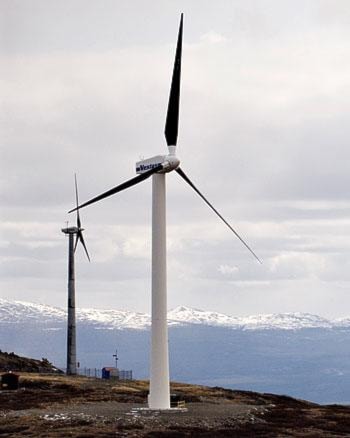The Yukon is building expensive hydro projects instead of cheaper windmills because the wind is too finicky, says the Yukon Energy Corporation president.
The public utility is getting flack from a local wind engineer who said the $140-million expansion of the Mayo dam and the $8-million third turbine at the Aishihik dam are bad investments.
The Yukon should press forward with more windmills, said Jean-Paul Pinard.
“Wind is a great compliment to hydro because the wind is stronger in the winter (when water levels go down),” said Pinard, who has done contract work for Yukon Energy as a “wind prospector.”
“Wind farms are sprouting up across Canada, and the Northwest Territories is looking at hooking up their communities to windmills,” said Pinard. “Meanwhile, in the Yukon there’s nothing going on.”
Yukon Energy could build a 20-megawatt wind farm for $80 million instead of hydro projects, he said.
While wind power may be cheaper, Yukon Energy was encouraged to expand the Mayo dam because Ottawa is pitching in $71 million to help build the expansion.
“It’s the only option that we had that would get us the federal money and that’s why we’re doing it,” said Yukon Energy president David Morrison.
The Ecoenergy for Renewable Energy program began helping windmill builders in January 2007, and was preceded by a similar Liberal program from the Chretien years.
The $1.48-billion fund will be depleted ahead of schedule for 2009, according the Canadian Wind Energy Association.
And earlier this year, Ottawa decided not to drop any new money into the fund in its January budget.
The federal subsidy for Mayo B makes the hydro project look cheaper than wind.
In terms of dollars for power, a wind farm costs around 30 cents a kilowatt/hour, said Morrison.
Mayo B is somewhere between eight and 10 cents a kilowatt/hour, he said.
But that’s the subsidized cost, which includes the money Ottawa has pitched in, said Pinard.
Despite that figure, both sides agree wind power is cheaper than hydro power.
“It’s slightly less; I think (Pinard’s) numbers are too high,” said Morrison.
Extra costs would also quickly appear on the balance sheet because of the wind’s unreliable nature, said Morrison.
“If you build five megawatts of hydro or wind, wind will be cheaper,” said Morrison. “But the difference is that, in very efficient wind projects - which the Yukon couldn’t have but let’s say that it could - the wind turbines would operate 30 per cent of the time.”
That means over a year, the wind is blowing optimally 30 per cent of the time.
“What do I do when the wind doesn’t blow?” said Morrison.
The Yukon’s only experiment in wind energy, two windmills on Haeckel Hill near Whitehorse, has an even worse track record.
“Our experience is 15 per cent efficiency,” he said. “That means I need something to replace the wind when it doesn’t blow.”
That would probably be diesel, he said.
“That’s when the economics of wind power gets blown right out of the water.”
The Haeckel Hill numbers aren’t fair because Yukon Energy doesn’t maintain those turbines properly, said Pinard.
“They don’t consider them a high priority,” he said.
That’s true. Yukon Energy doesn’t fix the windmills because they’ve been criticized during Yukon Utilities Board hearings for spending money on what’s considered a pilot project that doesn’t provide energy to the Yukon’s grid.
The Crown corporation also refrains from fixing the turbines in the winter when they freeze up because it’s unsafe for its employees.
“No argument that sometimes we let them go” said Morrison.
But even a good wind farm would only work 30 per cent of the time, and the Yukon needs a more reliable energy source.
“We’re not saying all wind is bad, we’re saying, in this instance, it’s not the right alternative because we’re going to have to supplement it with diesel,” said Morrison
Pinard thinks Yukon Energy is failing to ride the growing popularity of windmills.
“I can’t even practise my profession here because there’s nothing going on in the wind business,” said Pinard, who recently finished his doctorate on Yukon wind patterns.
But windmills are popular Outside because the big southern grids are all interconnected, said Morrison. When the wind doesn’t blow, provincial and private utilities can buy energy off other grids.
The Yukon is also looking for a quick fix to satisfy the sudden surge in electricity demand since the early 2000s. Big box stores, computer gadgets and more mines have all been blamed for an unexpected rise in energy demand.
The Mayo expansion was the only solution that could be built quickly enough, said Morrison.
Yukon Energy recently finished a wind study that found promise at two locations: Fairy Hill near Steward Crossing and Mount Sumanik near Whitehorse.
Wind farms are only feasible if there’s surplus hydro to toss around when the wind doesn’t blow, said Morrison.
But Pinard thinks Morrison has an attitude problem.
“It’s clear to me that David Morrison isn’t interested in wind energy,” said Pinard. “He’ll just try to find reasons not to fund wind power.”
Pinard used to work on wind studies funded by the Energy Solutions Center, which Yukon Energy used to help run.
He blames Morrison for axing those programs.
“He’s already made up his mind,” said Pinard.
But those wind studies, which involved wind measurements across the Yukon, were never very useful, said Morrison.
“None of those wind studies ever resulted in someone else building a wind turbine,” he said.
Contact James Munson at
jamesm@yukon-news.com.
